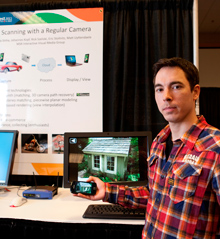 |
| Getting all the angles: Microsoft researcher Johannes Kopf demonstrates a cell phone app that can capture objects in 3-D. Credit: Microsoft |
Capturing an object in three dimensions needn't require the budget of Avatar. A new cell phone app developed by Microsoft researchers can be sufficient. The software uses overlapping snapshots to build a photo-realistic 3-D model that can be spun around and viewed from any angle.
"We want everybody with a cell phone or regular digital camera to be able to capture 3-D objects," says Eric Stollnitz, one of the Microsoft researchers who worked on the project.
To capture a car in 3-D, for example, a person needs to take a handful of photos from different viewpoints around it. The photos can be instantly sent to a cloud server for processing. The app then downloads a photo-realistic model of the object that can be smoothly navigated by sliding a finger over the screen. A detailed 360 degree view of a car-sized object needs around 40 photos, a smaller object like a birthday cake would need 25 or fewer.
If captured with a conventional camera instead of a cell phone, the photos have to be uploaded onto a computer for processing in order to view the results. The researchers have also developed a Web browser plug-in that can be used to view the 3-D models, enabling them to be shared online. "You could be selling an item online, taking a picture of a friend for fun, or recording something for insurance purposes," says Stollnitz. "These 3-D scans take up less bandwidth than a video because they are based on only a few images, and are also interactive."
To make a model from the initial snapshots, the software first compares the photos to work out where in 3-D space they were taken from. The same technology was used in a previous Microsoft research project, PhotoSynth, that gave a sense of a 3-D scene by jumping between different views (see video). However, PhotoSynth doesn't directly capture the 3-D information inside photos.
"We also have to calculate the actual depth of objects from the stereo effect," says Stollnitz, "comparing how they appear in different photos." His software uses what it learns through that process to break each image apart and spread what it captures through virtual 3-D space (see video, below). The pieces from different photos are stitched together on the fly as a person navigates around the virtual space to generate his current viewpoint, creating the same view that would be seen if he were walking around the object in physical space.
Look at the video HERE.
"This is an interesting piece of software," says Jason Hurst, a product manager with 3DMedia, which makes software that combines pairs of photos to capture a single 3-D view of a scene. However, using still photos does have its limitations, he points out. "Their method, like ours, is effectively time-lapse, so it can't deal with objects that are moving," he says.
3DMedia's technology is targeted at displays like 3-D TVs or Nintendo's new glasses-free 3-D handheld gaming device. But the 3-D information built up by the Microsoft software could be modified to display on such devices, too, says Hurst, because the models it builds contain enough information to create the different viewpoints for a person's eyes.
Hurst says that as more 3-D-capable hardware appears, people will need more tools that let them make 3-D content. "The push of 3-D to consumers has come from TV and computer device makers, but the content is lagging," says Hurst. "Enabling people to make their own is a good complement."
